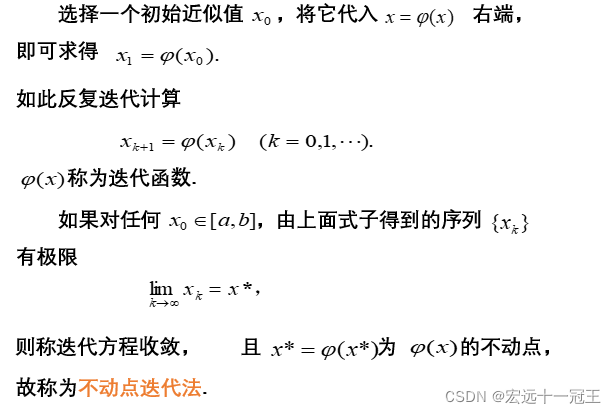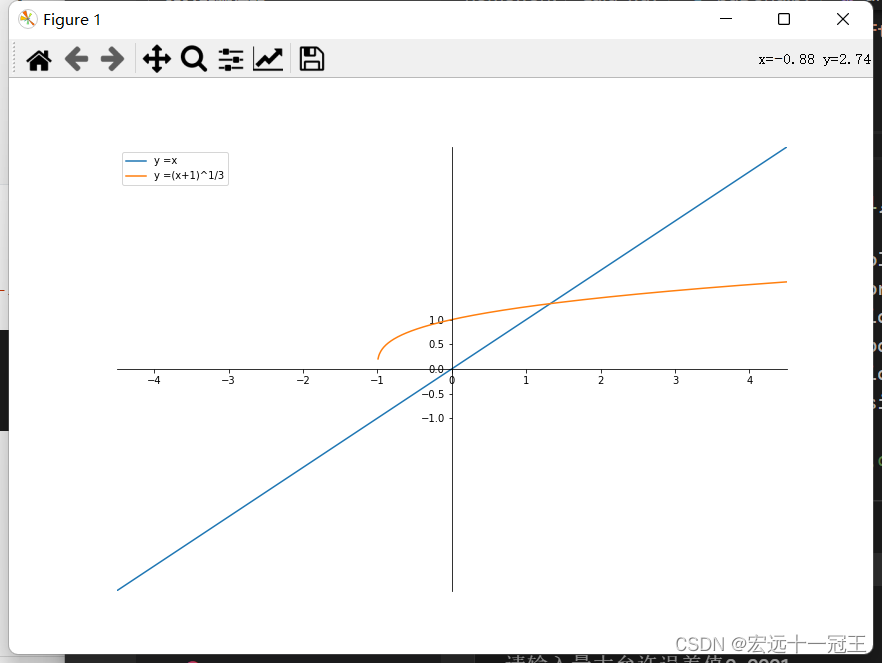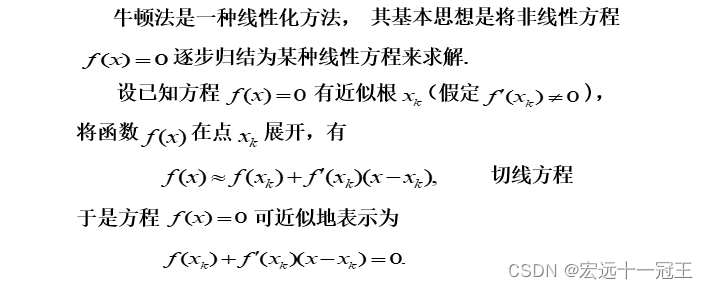不动点迭代法和牛顿迭代法
不定点迭代法
方程的根

不动迭代法的概念

代码实现
import numpy
import numpy as np
from sympy import *
import math
import matplotlib.pyplot as plt
from sympy.simplify.fu import L
def detfunction(x):
return pow((x+1), 1/3)
def erfen(point1, point2, min_area):
min = point1
max = point2
isquit = True
while isquit:
mid = point1+1/2*(point2-point1)
if detfunction(mid) * detfunction(min) <= 0:
max = mid
elif detfunction(mid)*detfunction(max) < 0:
min = mid
if(math.fabs(max-min) < min_area):
isquit = False
return min, max
def calu_result(accuary, point):
minarea = 1
# erfen()
isquit = True
first = point
count = 0 #次数
while isquit:
# 计算结果
res = detfunction(first)
if(abs(first-res) < accuary):
first = res
isquit = False
first = res
count += 1
return first, count
def draw(left, right):
# x = np.arange(left-5,right+5,0.1)
# x_v = x
# y = []
# for i in range(len(x)):
# res =detfunction(x[i])
# y.append(res)
# plt.plot(x,x_v,label = "y=x")
# plt.plot(x,y,label = "y = (x+1)^1/3")
# # ax = gca()
# plt.show()
plt.figure(figsize=(12, 8), dpi=72)
plt.subplot(1, 1, 1)
X = np.linspace(-10,10, 2048, endpoint=True)
X_val = X
Y_val = np.zeros(len(X))
for i in range(len(X)):
res = detfunction(X[i])
Y_val[i] = res
plt.plot(X, X_val, linewidth=1.5, linestyle="-", label="y =x")
plt.plot(X, Y_val, linewidth=1.5, linestyle="-", label="y =(x+1)^1/3")
plt.legend(loc='upper left')
plt.xlim(-4.5, 4.5)
# 设置纵轴的上下限
plt.ylim(-4.5, 4.5)
# 设置纵轴记号
plt.yticks(np.linspace(-1, 1, 5, endpoint=True))
ax = plt.gca()
ax.spines['right'].set_color('none')
ax.spines['top'].set_color('none')
ax.xaxis.set_ticks_position('bottom')
ax.spines['bottom'].set_position(('data', 0))
ax.yaxis.set_ticks_position('left')
ax.spines['left'].set_position(('data', 0))
# savefig("sincosin.png",dpi=72) #以72dpi保存图像
plt.show()
point = float(input("请输入迭代法的初始值"))
accuary = float(input("请输入最大允许误差值"))
res, count = calu_result(accuary, point)
print(f"结果:{res}")
print(f"迭代次数:{count}")
ma = max(res, point)
small = min(res, point)
draw(small*0.8, ma*1.2)
实验样例

函数的图像

样例2


牛顿法、牛顿简化法,牛顿下山法
牛顿法


迭代函数

牛顿简化法
由于牛顿法计算导数时比较困难,就用写于为f(x0)的导数的平行弦与x轴的交点来替代


牛顿下山法



代码实现
牛顿法
def calu_result(diff_function,function,accuary,point,x):
is_quit = True
Init_first = point
count =0 #次数
while is_quit:
res1 = function.subs(x,Init_first)
res2 = diff_function.subs(x,Init_first)
temp = Init_first-(res1/res2) #每次迭代的xk
if abs(temp-Init_first)<accuary:
Init_first = temp #更新xk
count+=1
return Init_first,count
if(count>100):
return temp,count
Init_first = temp
count+=1
牛顿简化法
def calu_Simple_result(diff_function,function,accuary,point,x):
is_quit = True
Init_first = point
count =0 #次数
res2 = diff_function.subs(x,Init_first) #平行弦
while is_quit:
res1 = function.subs(x,Init_first)
temp = Init_first-(res1/res2)
if abs(temp-Init_first)<accuary:
Init_first = temp
count+=1
return Init_first,count
if(count>100):
return temp,count
Init_first = temp
count+=1
牛顿下山法
def mountain_result(diff_function,function,accuary,point,x):
is_quit = True
Init_first = point
second =point
count =0
weight = 1
is_mul = False
#计算下山因子
while is_quit!=False:
res1 = function.subs(x,second)
res2 = diff_function.subs(x,second)
temp = second-(res1/res2)
if abs(detfunction(temp))-abs(detfunction(second)) <0:
break
#每次减半,直到合适的下山因子
weight = weight/2
second = temp
# print(weight)
while is_quit:
#根据下山因子计算
res1 = function.subs(x,Init_first)
res2 = diff_function.subs(x,Init_first)
temp = Init_first - weight*(res1/res2)
if abs(temp-Init_first)<accuary:
Init_first = temp
return Init_first,count,weight
#设定一个,100轮还没有结束,也退出,相当于一个最大迭代次数
if(count>100):
return temp,count,weight
Init_first = temp
count+=1
三种方法实验结果
样例1

第一行为求导后的表达式,后面的为迭代次数和结果

当取初值为0.6时,应该可能出现,离根比较远的情况,此时牛顿法收敛法比较慢,而牛顿简化法已经不满足收敛条件了,而牛顿下山法可以保证它的收敛性,慢慢逼近根
全部代码
不动点迭代法
import numpy
import numpy as np
from sympy import *
import math
import matplotlib.pyplot as plt
from sympy.simplify.fu import L
def detfunction(x):
return 1/exp(x)
def erfen(point1, point2, min_area):
min = point1
max = point2
isquit = True
while isquit:
mid = point1+1/2*(point2-point1)
if detfunction(mid) * detfunction(min) <= 0:
max = mid
elif detfunction(mid)*detfunction(max) < 0:
min = mid
if(math.fabs(max-min) < min_area):
isquit = False
return min, max
def calu_result(accuary, point):
minarea = 1
# erfen()
isquit = True
first = point
count = 0 #次数
while isquit:
# 计算结果
res = detfunction(first)
if(abs(first-res) < accuary):
first = res
isquit = False
first = res
count += 1
return first, count
def draw(left, right):
# x = np.arange(left-5,right+5,0.1)
# x_v = x
# y = []
# for i in range(len(x)):
# res =detfunction(x[i])
# y.append(res)
# plt.plot(x,x_v,label = "y=x")
# plt.plot(x,y,label = "y = (x+1)^1/3")
# # ax = gca()
# plt.show()
plt.figure(figsize=(12, 8), dpi=72)
plt.subplot(1, 1, 1)
X = np.linspace(-10,10, 2048, endpoint=True)
X_val = X
Y_val = np.zeros(len(X))
for i in range(len(X)):
res = detfunction(X[i])
Y_val[i] = res
plt.plot(X, X_val, linewidth=1.5, linestyle="-", label="y =x")
plt.plot(X, Y_val, linewidth=1.5, linestyle="-", label="y =1/e^x")
plt.legend(loc='upper left')
plt.xlim(-4.5, 4.5)
# 设置纵轴的上下限
plt.ylim(-4.5, 4.5)
# 设置纵轴记号
plt.yticks(np.linspace(-1, 1, 5, endpoint=True))
ax = plt.gca()
ax.spines['right'].set_color('none')
ax.spines['top'].set_color('none')
ax.xaxis.set_ticks_position('bottom')
ax.spines['bottom'].set_position(('data', 0))
ax.yaxis.set_ticks_position('left')
ax.spines['left'].set_position(('data', 0))
# savefig("sincosin.png",dpi=72) #以72dpi保存图像
plt.show()
point = float(input("请输入迭代法的初始值"))
accuary = float(input("请输入最大允许误差值"))
res, count = calu_result(accuary, point)
print(f"结果:{res}")
print(f"迭代次数:{count}")
ma = max(res, point)
small = min(res, point)
draw(small*0.8, ma*1.2)
牛顿迭代法
import numpy
import numpy as np
from sympy import *
import math
import matplotlib.pyplot as plt
from sympy.simplify.fu import L
def draw(left, right):
# x = np.arange(left-5,right+5,0.1)
# x_v = x
# y = []
# for i in range(len(x)):
# res =detfunction(x[i])
# y.append(res)
# plt.plot(x,x_v,label = "y=x")
# plt.plot(x,y,label = "y = (x+1)^1/3")
# # ax = gca()
# plt.show()
plt.figure(figsize=(12, 8), dpi=72)
plt.subplot(1, 1, 1)
X = np.linspace(-10,10, 2048, endpoint=True)
X_val = X
Y_val = np.zeros(len(X))
for i in range(len(X)):
res = detfunction(X[i])
Y_val[i] = res
plt.plot(X, X_val, linewidth=1.5, linestyle="-", label="y =x")
plt.plot(X, Y_val, linewidth=1.5, linestyle="-", label="y =(x+1)^3-x-1")
plt.legend(loc='upper left')
plt.xlim(-4.5, 4.5)
# 设置纵轴的上下限
plt.ylim(-4.5, 4.5)
# 设置纵轴记号
plt.yticks(np.linspace(-1, 1, 5, endpoint=True))
ax = plt.gca()
ax.spines['right'].set_color('none')
ax.spines['top'].set_color('none')
ax.xaxis.set_ticks_position('bottom')
ax.spines['bottom'].set_position(('data', 0))
ax.yaxis.set_ticks_position('left')
ax.spines['left'].set_position(('data', 0))
# savefig("sincosin.png",dpi=72) #以72dpi保存图像
# 在屏幕上显示
plt.show()
def getdiff(function,x):
return diff(function,x)
def detfunction(x):
return pow(x,3)-x-1
def calu_Simple_result(diff_function,function,accuary,point,x):
print("牛顿简化法")
is_quit = True
Init_first = point
count =0
res2 = diff_function.subs(x,Init_first)
while is_quit:
res1 = function.subs(x,Init_first)
temp = Init_first-(res1/res2)
print(f"第{count}的值{temp}")
if abs(temp-Init_first)<accuary:
Init_first = temp
count+=1
return Init_first,count
if(count>100 or abs(temp-Init_first)>100000):
return temp,count
Init_first = temp
count+=1
def calu_result(diff_function,function,accuary,point,x):
print("牛顿法")
is_quit = True
Init_first = point
count =0
while is_quit:
res1 = function.subs(x,Init_first)
res2 = diff_function.subs(x,Init_first)
temp = Init_first-(res1/res2)
print(f"第{count}的值:{temp}")
if abs(temp-Init_first)<accuary:
Init_first = temp
count+=1
return Init_first,count
if(count>100):
return temp,count
Init_first = temp
count+=1
def mountain_result(diff_function,function,accuary,point,x):
print("牛顿下山法")
is_quit = True
Init_first = point
second =point
count =0
weight = 1
is_mul = False
while is_quit!=False:
res1 = function.subs(x,second)
res2 = diff_function.subs(x,second)
temp = second-(res1/res2)
if abs(detfunction(temp))-abs(detfunction(second)) <0:
break
weight = weight/2
second = temp
# print(weight)
while is_quit:
res1 = function.subs(x,Init_first)
res2 = diff_function.subs(x,Init_first)
temp = Init_first - weight*(res1/res2)
print(f"第{count}的值{temp}")
if abs(temp-Init_first)<accuary:
Init_first = temp
return Init_first,count,weight
if(count>100):
return temp,count,weight
Init_first = temp
count+=1
x = symbols('x')
function = detfunction(x)
diff_function = getdiff(function,x)
print(diff_function)
point = float(input("请输入迭代法的初始值"))
accuary = float(input("请输入最大允许误差值"))
res, count = calu_result(diff_function,function,accuary, point,x)
res2,count2 = calu_Simple_result(diff_function,function,accuary, point,x)
res3,count3,weight = mountain_result(diff_function,function,accuary, point,x)
if count!=100:
print(f"牛顿法结果:{res}")
print(f"迭代次数:{count}")
# else:
# print(f"迭代次数:{count}")
# print(f"牛顿法结果:{res},达到最大迭代次数")
if count2!=100:
print(f"牛顿简化法结果:{res2}")
print(f"迭代次数:{count2}")
# else:
# print(f"牛顿简化法结果:{res2}")
# print(f"迭代次数:{count2},达到最大迭代次数")
if count3!=100:
print("下山因子为:{}".format(weight))
print(f"牛顿下山法结果:{res3}")
print(f"迭代次数:{count3}")
ma = max(res, point)
small = min(res, point)
draw(small*0.8, ma*1.2)
总结
本文是学习的一些笔记,创作不易,点个爱心是缘分,不点是本分,如果有问题可以私信或者在下面评论,大家可以一起学习!!!



